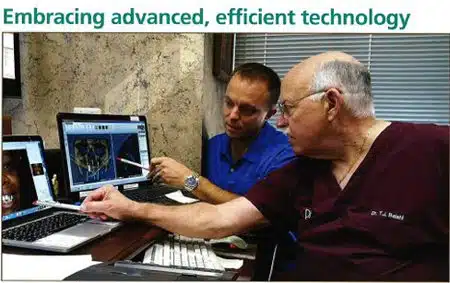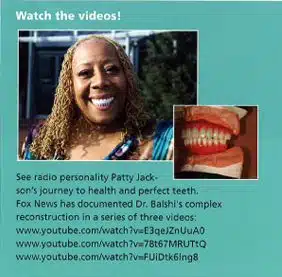Temple University’s Diamond Magazine (Fall 2016)
Pi Dental Center is Embracing advanced, efficient technology. What’s Happening Now. What to expect in the Future.
Thomas J. Balshi, DDS, PhD, FACP ’72, develops a strategic digital plan with Stephen F. Balshi, Biomedical Engineer. Dr. Balshi, founder of Pi Dental Center in Fort Washington, Pa, provides patients with monolithic, fully milled digital dentures as well as with implant supported fixed prosthesis.
“Remember Jurassic Park?” asks Dr. Thomas Balshi. “When Billy takes Dr. Grant into the tent to show him the rapid prototyper? It’s stereolithography, printing 3D from layers of 2D images. And it’s what we can do with digital dentistry.”
“For instance, 2D data files can be put into other software to see the 3D surgical plan. That’s then the basis for templates to show where the implants and teeth will go. “It’s similar to the stencils that kids use to draw,” says Balshi. And it’s all part of today’s CAD/CAM restorations, which Balshi assures are better fitting, more durable and more natural looking than ever before.
He uses the technology in several ways: for patients who would normally need six to eight implants and now can have four that secure a digital dental prosthesis-or for a permanent digital denture anchored with four to six implants. In either case, the reconstruction uses a robotically milled prosthesis on a titanium-milled framework. He emphasizes that the proprietary surgical procedure, which he developed with Global Dental Science, is faster and simpler than others and is streamlined with the patient’s digital records to provide permanent digital records for future “teeth forever.” For a digital dental prosthesis, “It’s an economic shift in treatment protocol,” says Balshi, “since there are fewer implants.” For digital dentures, the process can take what Balshi calls “a failed situation” and turn it into “what looks normal again.”
A case in point is Patty Jackson, WDAS radio’s R&B soul “mid-day maven” well known in Philadelphia and 16 other U.S. markets. She came to Balshi for treatment and then went on TV with her story because her extreme condition of periodontally hopeless teeth and bone atrophy could show others what is now possible in a few reconstruction visits.
A video series shows Balshi first stepping in with a day of molding, imaging and measuring after her primary dentist did extractions. That prep work helps plan surgery for her next visit when Balshi and his team remove the remaining teeth before putting in implants and screwing them to a temporary digital denture. Later when the permanent denture is built, he uses an in-house scanning lab and an Arizona-based lab to produce robotically milled teeth in dental ceramic for the top and in a stronger acrylic for the bottom. Then, artful coloring and carved veining go through crystallization to make the denture look real. Once secured in place, the set delights Jackson “with a new mouth” that “looks beautiful!”
Minimally invasive procedure
Clearly, the benefits of this surgery are a boon to such patients. Despite the severity of their bone atrophy, they usually undergo a single surgical procedure that is minimally invasive, avoiding bone grafting. “It’s precise just like a Swiss watch,” Balshi says. “The fit is excellent due to robotic milling of an entire piece rather than individual teeth. Also, the digital denture is more comfortable than standard dentures, 50 times stronger and resists bacteria due to the nonporous, bio-hygienic material.”
Explaining further he says, “The patient’s anatomy determines the distribution of implants in the arch. For instance, the sinuses may dictate implant positional angulation.”
He adds: “We can be an instant orthodontist, morphing teeth, making them longer or thinner or rounder positioning them correctly on the arch form.”
This kind of expedited care that provides excellent results with increased chairside comfort is the backbone of digital prosthetic dentistry. Balshi agrees with others using the technology who says it achieves high patient satisfaction because patients spend less time with the dentist and can approve a design on the computer screen before milling. It is rewarding for dentists, too, because what used to take 100 hours of labor can now be done at the push of a button.
What does he see for the future? “Robotics will be playing a greater role,” he says. Also, he believes that today’s dental students-familiar with manipulating images in 3D-will make an easy lateral shift to the new technology. That’s important because he would like students “to pay close attention to current technology trends as they will be critical for establishing a successful dental practice.”
In addition, he looks forward to open platforms and shared files as applications talk to each other, with data from one program connecting with another and with one business enterprise linking to another. “The future will be a unified workflow. There were too many closed platforms before..…It will just be more elegant and streamlined.

